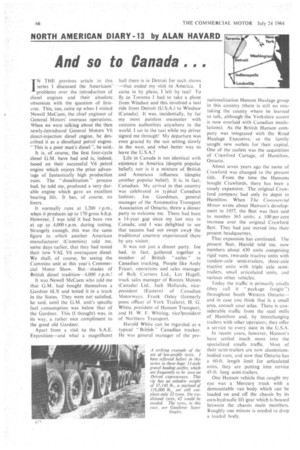NORTH AMERICAN DIARY-13 by ALAN HAVARD
Page 68

If you've noticed an error in this article please click here to report it so we can fix it.
And so to Canada
IN THE previous article in this series I discussed the Americans' problems over the introduction of diesel engines and their absolute _ obsession with the question of firstcost. This, too, came up when I visited Newell McCuen, the chief engineer of General Motors' overseas operations. When we were talking about the then newly-introduced General Motors V6 direct-injection diesel engine, he described it as a dieselized petrol engine. " This is a poor man's diesel ", he said., It is, of course, the first .four-cycle diesel G.M. have had and is, indeed, based on their successful Vb petrol engine which enjoys the price advantage of fantastically high production runs. The " dieselization " process had, he told me, produced a very durable engine which gave an excellent bearing life. It has, of course, no liners.
It normally runs at 3,200 r.p.m.', when it produces Up to 170 gross b.h.p. However, I was told it had been run at. up to .4,000 r.p.m. during testing. Strangely enough; this was the same figure to which another American manufacturer, (Cumrnins) told me, some days earlier, that they had tested their new. VAL Vb oversquare diesel. We shall, of course, be seeing the Cummins unit at this year's Commercial Motor Show. But—shades of British diesel tradition-4,000 r.p.m.!
It was Newell McCuen who told me that G.M. had bought themselves a Gardner 6LX and tested it in a truck in the States. They were not satisfied, he said, until the G.M. unit's specific fuel consumption was below that of the Gardner. This (I thought) was, in its Way, a rather nice compliment to the good old Gardner.
• Apart from a visit to the S.A.E.
Exposition and what a magnificent
hall there is in Detroit for such shows —that ended my visit to America. I came in by plane, I left by taxi! To fly to Toronto I had to take a plane from Windsor and this involved a taxi ride from Detroit (U.S.A.)to Windsor (Canada). It was, incidentally, by far my most painless encounter with customs authorities anywhere in the world. I sat in the taxi while my driver signed me through! My departure was even graced by the sun setting slowly in the west, and What better way to leave the U.S.A.?
-Life in Canada is not identical with existence in America (despite popular belief); nor is it a mixture of British and American influence (despite :another popular belief). It is, in fact, Canadian. My arrival In that country was celebrated in typical Canadian fashion; Joe Goodman, 'general manager of the Automotive Transport Association of Ontario, threw a dinner party to welcome me. There had been a 14-year gap since my last stay in Canada; and. I was delighted to see that success had not swept away the traditional courtesy experienced there by any visitor.
It was not just a dinner party. Joe had, in fact, gathered together a number of BritOt " exiles" in Canadian trucking. People like Andy Fraser, operations and sales manager of Bulk Carriers Ltd.. Les Hagell, truck sales manager of Rootes Motors (Canada) Ltd., Jack Hollands, vicepresident (Eastern) of Canadian Motorways, Frank Oxley (formerly press officer of York Trailers), H. G. White, president of Hanson Transport, and H. W. F. Whiting, vice-'president of Northern Transport.
Harold White can be regarded as a typical " British " Canadian trucker. He was general manager of the pre
nationalization Hanson Haulage group in this country (there is still no mistaking the county where he learned to talk, although the Yorkshire accent is now overlaid with Canadian modulations). As the British Hanson company was integrated with the Road Haulage Executive, so the family • sought new outlets for 'their, capital.. One of the outlets was the acquisition of Crawford Cartage, of Hamilton, Ontario.
About seven years ago the name of Crawford was changed to the present title. From the time the Hansons bought Crawfords, there has been a steady expansion. The original Crawford company had only its depot in Hamilton. When The Commercial Motor wrote about Hanson's development in 1957; the fleet was then said to number 365 units; a 100 per cent increase over the original Crawford Meet. They had just moved into their. present headquarters.
That expansion has continued. The present fleet. Harold told me, now numbers about 430 units comprising rigid vans, two-axle tractive units with tandem-axle semi-trailers, three-axle tractive units with triple axle semitrailers. small articulated units, and various .other vehicles.
Today the traffic is primarily smalls (they call it package freight ") throughout South Western Ontario— and in case you think that fs a small area, consult your atlas. There is considerable traffic from the steel mills of Haniilton and, by interchanging trailers with other operators, they offer a service to every state in the U.S.A.
In recent years, however. Hanson's have settled much more into the specialized smalls traffic. Most of their semi-trailers are now aluminiumbodied vans, and now that Ontario has a 60-ft. length limit for articulated units, .they are putting into service 45-ft. 'long genii-trailers.
One Hanson vehicle that caught my eye was a Mercury truck with a demountable van body which can be loaded on and off the chassis by its own-hydraulic lift gear which is housed between the chassis main members. Roughly one minute is needed to drop a loaded body,
















































































































